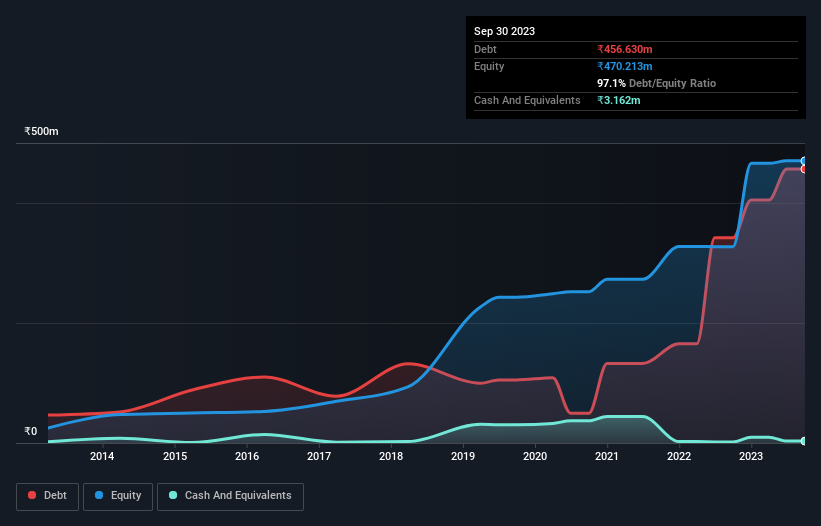
Warren Buffett famously said, 'Volatility is far from synonymous with risk.' So it seems the smart money knows that debt - which is usually involved in bankruptcies - is a very important factor, when you assess how risky a company is. We can see that Ushanti Colour Chem Limited (NSE:UCL) does use debt in its business. But the more important question is: how much risk is that debt creating?
What Risk Does Debt Bring?
Debt is a tool to help businesses grow, but if a business is incapable of paying off its lenders, then it exists at their mercy. If things get really bad, the lenders can take control of the business. However, a more common (but still painful) scenario is that it has to raise new equity capital at a low price, thus permanently diluting shareholders. Of course, debt can be an important tool in businesses, particularly capital heavy businesses. When we think about a company's use of debt, we first look at cash and debt together.
View our latest analysis for Ushanti Colour Chem
What Is Ushanti Colour Chem's Debt?
As you can see below, at the end of September 2023, Ushanti Colour Chem had ₹456.6m of debt, up from ₹341.9m a year ago. Click the image for more detail. And it doesn't have much cash, so its net debt is about the same.

A Look At Ushanti Colour Chem's Liabilities
According to the last reported balance sheet, Ushanti Colour Chem had liabilities of ₹340.6m due within 12 months, and liabilities of ₹271.5m due beyond 12 months. Offsetting these obligations, it had cash of ₹3.16m as well as receivables valued at ₹266.5m due within 12 months. So it has liabilities totalling ₹342.4m more than its cash and near-term receivables, combined.
While this might seem like a lot, it is not so bad since Ushanti Colour Chem has a market capitalization of ₹695.4m, and so it could probably strengthen its balance sheet by raising capital if it needed to. But we definitely want to keep our eyes open to indications that its debt is bringing too much risk. The balance sheet is clearly the area to focus on when you are analysing debt. But you can't view debt in total isolation; since Ushanti Colour Chem will need earnings to service that debt. So if you're keen to discover more about its earnings, it might be worth checking out this graph of its long term earnings trend.
In the last year Ushanti Colour Chem had a loss before interest and tax, and actually shrunk its revenue by 30%, to ₹377m. That makes us nervous, to say the least.
Caveat Emptor
While Ushanti Colour Chem's falling revenue is about as heartwarming as a wet blanket, arguably its earnings before interest and tax (EBIT) loss is even less appealing. To be specific the EBIT loss came in at ₹21m. Considering that alongside the liabilities mentioned above does not give us much confidence that company should be using so much debt. So we think its balance sheet is a little strained, though not beyond repair. However, it doesn't help that it burned through ₹194m of cash over the last year. So suffice it to say we consider the stock very risky. When analysing debt levels, the balance sheet is the obvious place to start. But ultimately, every company can contain risks that exist outside of the balance sheet. For example Ushanti Colour Chem has 6 warning signs (and 4 which can't be ignored) we think you should know about.
At the end of the day, it's often better to focus on companies that are free from net debt. You can access our special list of such companies (all with a track record of profit growth). It's free.
New: AI Stock Screener & Alerts
Our new AI Stock Screener scans the market every day to uncover opportunities.
• Dividend Powerhouses (3%+ Yield)
• Undervalued Small Caps with Insider Buying
• High growth Tech and AI Companies
Or build your own from over 50 metrics.
Have feedback on this article? Concerned about the content? Get in touch with us directly. Alternatively, email editorial-team (at) simplywallst.com.
This article by Simply Wall St is general in nature. We provide commentary based on historical data and analyst forecasts only using an unbiased methodology and our articles are not intended to be financial advice. It does not constitute a recommendation to buy or sell any stock, and does not take account of your objectives, or your financial situation. We aim to bring you long-term focused analysis driven by fundamental data. Note that our analysis may not factor in the latest price-sensitive company announcements or qualitative material. Simply Wall St has no position in any stocks mentioned.
About NSEI:UCL
Ushanti Colour Chem
Manufactures and sells chemicals, dyes, and intermediates in India.
Slight and slightly overvalued.
Similar Companies
Market Insights
Community Narratives




